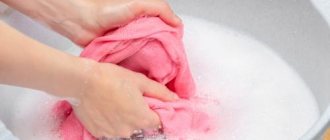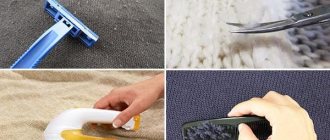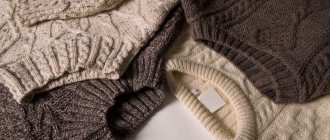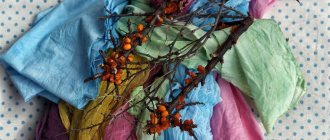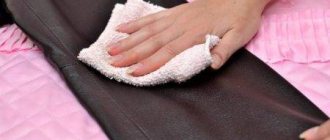Very often, housewives are faced with an unpleasant situation: after careless washing or long wear, a knitted woolen item “fails.” Its original elegant appearance is lost, and the wool in some places sometimes becomes matted to the state of felt. You can, of course, throw away such a thing or cut it into rags. Some especially thrifty women manage to cut out fragments from such things that have lost their presentable appearance that have been preserved in their original form. And on their basis they create new things, knit them, sew them on, etc. But often it is simply a pity to throw away the expensive yarn from which such elegant sweaters and dresses were once knitted. And I don’t want to waste them either. In this regard, many housewives ask the question: “Is it possible to unravel an old knitted product with the least damage to the yarn. And if possible, what is the best way to do this?”
According to many experienced craftswomen, almost any thing can be unraveled . But this procedure in some situations can take too much time and effort.
Before getting down to business, you should take a good look at the product planned for dissolution and think about whether the game is worth the candle? Or is it easier to buy new wool yarn from which to knit a similar item?
How to restore mohair?
To restore the fluff of mohair, angora, mink and other types of fluffy yarn, you need to blow the product with a cool (never hot) hairdryer. First you need to blow the thing from the inside so that the fluff comes out, then blow it from the outside in the same way, as if combing the fluff with a hairdryer.
Interesting materials:
How to make a microphone on a laptop? How to make mercy in MK 11? How to make my computer appear in the taskbar? How to make milk mushroom from scratch? How to make carrots on a ribbon with your own hands? How to make a sailor's maritime documents? How to make a mosquito net for a wooden window? How to register a citizen of the Russian Federation in Moscow? How to make a multiboot rufus flash drive? How to make a multiboot flash drive?
Unraveling a worn knitted item
If your old knitted item has lost its original appearance, but the yarn itself is still strong enough, then do not rush to throw it away. Try giving the yarn a second life. Unravel the item, you can re-dye the yarn and knit something new and original from it. Let's take a closer look at how to unravel a knitted product.
If you are planning to unravel a knitted item, then first consider how it is knitted. If your item is knitted by hand, then first carefully open the seams and find the end of the thread with which you finished knitting the item. As a rule, they knit from the bottom up, so you need to start looking for the end of the thread from the top of the part.
If the item is factory-made, then look at the way the item is knitted. Sometimes at the factory an item is cut out from a whole knitted fabric. In this case, there is no point in unraveling the product, since the thread will break in each row and as a result you will end up with a ball consisting of only scraps. If the factory product is a one-piece knitted product, then the item can be unraveled, as with hand knitting.
If an item has become very matted during wear, then unraveling it is quite problematic and often you have to abandon the idea of unraveling it. But before you give up, try the following:
- Prepare a solution: 10 liters of soapy water, 3 tablespoons of ammonia, 1 tablespoon of turpentine, 1 tablespoon of wine alcohol.
- Place the matted item in this solution and leave it for a day.
- After a day, rinse the product well in warm water with table vinegar (1 tablespoon per 1 liter of water).
- Dry the product.
When unraveling the product, sort the yarn according to its quality. Separate the stronger thread from the weaker thread. Simply throw away the worn out places and tie the remaining ends with a knot. How to tie the ends of threads, read the article “Tying the ends of yarn threads.”
In the future, it is better to use a stronger thread for the sleeves, and a less durable thread for the back or front.
When unraveling the product, first wind the yarn into balls. But do not forget that you cannot wind the yarn into a tight ball. Read about the features of winding yarn into a ball in the article “Winding Yarn into a Ball.” After you have unraveled the entire product, rewind the yarn from balls into skeins (For more information on how this can be done, read the article “winding yarn using winders”).
After unraveling the old product, the yarn turns out wavy and it is very inconvenient to knit from it again. Moreover, the tension of such a thread can change when knitting, and the loops will turn out uneven and loose. The appearance of the product will be sloppy. Therefore, after unraveling the old item, you need to try to straighten the yarn. This can be done in several ways, which are discussed in detail in the article “The second life of used yarn.”
We looked in detail at how to unravel a worn knitted item. If you have any questions or want to discuss something, be sure to leave a comment.
You might be interested to see:
| Yarn: how to choose and what to pay attention to | Second life for used yarn | Product properties depending on yarn composition |
Copying site materials is possible only with an active direct link (open for indexing) to the source and a mention of the author of the material.
© 2022 Brand new. All rights reserved.
Mechanical and thermal recovery method
You can restore shrunken clothing by mechanically stretching it with your hands or by attaching it to a mannequin of a suitable size.
- You need to start working by soaking the deformed product in warm water for 15-20 minutes.
- After this time, the woolen item is removed from the container and laid out on a wire rack located above the bathtub or basin.
- When the excess liquid has drained, the product is dried a little, wrapped in a terry towel, and then pulled onto the prepared mannequin.
- While the sweater is drying, you need to periodically come up and pull the sleeves and fronts down.
To stretch a wool hat, just soak it in warm water, add a little shampoo or conditioner, and stretch it onto a 3-liter jar. The product will dry and acquire the desired size.
Sometimes the problem can be solved by steaming with an iron. The ironing board is covered with damp gauze. A woolen product is laid out on it, covered with another layer of wet fabric and steamed with an iron. When wet material is heated, a powerful stream of steam is formed, which passes through the wool, slightly pushing the fibers apart.
Kill unpleasant odors with vodka
Sweaters, especially those purchased from vintage stores, can have an unpleasant odor. You can get rid of it easily and simply. Regular vodka will kill the unpleasant smell. This will kill bacteria and at the same time stale smell. Just sprinkle a little vodka on your sweater. Then hang the sweater in a well-ventilated area, such as a balcony. I advise you to test this method on a small area of the sweater before spraying vodka over the entire surface.
Method number 1: use hair balm
What to do if a woolen product has shrunk and become smaller in size - of course, stretch it!
The safest way is to use any hair conditioner or special conditioner for washing wool products. Take a basin, pour warm water into it and add 2-3 caps of hair conditioner that you have in your bathroom. Conditioner balm improves the quality of wool and prevents shrinkage of the product. Stir the solution thoroughly and lower the woolen item. Leave and do not touch the wool for about 15 minutes. After 15 minutes, take out the woolen product, let the water drain, wrap it in a roll in an old terry towel, thereby removing excess water.
Why does a sweater stretch after washing?
The main reasons for the deformation of our sweaters are improper washing and improper drying. But these are far from the only “culprits” of the problem. Some things stretch even from prolonged wear, some - due to the bad habits of their owner. Some people like to stretch the bottom, the neck of the sweater, and pull out the sleeves to plunge into them to the tips of their fingers. All these manipulations lead to stretching of certain parts of the product.
The rapid deformation of a sweater also depends on the density of the loops. So, if a product is machine knitted, then it is denser and therefore less susceptible to stretching. But cozy hand-knitted sweaters, on the contrary, have weaker stitch density, no matter how hard the needlewoman tries. That is why “handmade” products are stretched more often under the influence of various circumstances.
Advice! Always before washing, drying and even wearing a sweater, read the information provided by the manufacturer about this product - on the label, packaging, and official website.
For all of the above cases, we have found universal ways to eliminate the consequences.
New yarn is the ultimate dream
Knitting with new yarn is a pleasure. Until the label is removed from the little balls, their potential is limitless. These are future cardigans, dresses, tops, swimsuits, hats, blankets and pillows.
I just love tearing off the label, taking out the edge of the thread and making the first loop. It's like opening the page of a brand new notebook and writing the first word. You can sing about the delights of the new yarn for a long time and verbosely, but I will limit myself to one phrase: it is incomparable. Especially when the material is really high quality.
Obvious advantages:
- Uniform thread thickness (unless uneven twist is not included in the yarn design).
- Smooth fabric (loops and posts of the same size).
- Thanks to the labels, you can easily determine the weight of the skeins and the length of the thread. That is, it is easier to calculate the material consumption and purchase the missing skeins.
Flaws:
- Price! Of course, the cost of new yarn is much higher than the so-called “recycled” yarn. In addition to the cost of the material, we also have to pay for delivery.
- "A dark horse". If we buy new yarn that we have not worked with before, we cannot predict how the material will behave when worn. The fabric may become covered with pills, shrink, stretch, fade, or even bunch up into felt after washing.
LiveInternetLiveInternet
—Links
-Music
-News
—Tags
—Categories
- Games, flash drives (21)
- Learning languages (7)
- Windows10 (1)
- Computer Security (53)
- “To be remembered” (19)
- — Orthodox calendar (1)
- Aleo Flash Intro Banner Maker (7)
- Format Factory video conversion (4)
- Gimp - graphics editor (8)
- Paint and Paint.Net (19)
- PhotoFiltre studio x 10.7.1 (1)
- ProShow Producer (43)
- Sony Vegas Pro (4)
- YouTube (11)
- Mozilla FireFox browser (36)
- In the world of interesting things (30)
- Virtual tours (3)
- KNITTING (1062)
- bolero, shrugs (10)
- Bruges lace (5)
- mittens, mittens, gloves (8)
- Vologda lace (7)
- fur knitting (10)
- knitting on a fork (8)
- knitted items for home (82)
- for children (72)
- for animals (2)
- for men (8)
- knitting magazines, websites (14)
- from plastic bags (3)
- Irish lace (73)
- cardigans, jackets, skirts (74)
- rugs (6)
- combined (+leather, fabric) (12)
- swimwear (8)
- socks, slippers, boots (67)
- dresses, tunics (26)
- blankets, bedspreads (26)
- ponchos, capes (12)
- pullovers, jumpers, sleeveless vests (101)
- Romanian lace (14)
- tablecloths, napkins (13)
- knitting techniques, tips (65)
- tops, sundresses (49)
- crochet patterns (101)
- knitting patterns (66)
- jewelry, necklace (16)
- fillet knitting (3)
- freeform (19)
- shawls, scarves, shirtfronts (62)
- hats, berets (57)
- hats (46)
- shorts (1)
- DECOUPAGE (561)
- Bottles, jars, vases (54)
- Sundries (65)
- Decoupage furniture (27)
- Decoupage on fabric (10)
- Imitations (39)
- Books, encyclopedias on decoupage (10)
- Materials for decoupage (52)
- Paper art (36)
- Plates (9)
- Decoupage and decoration techniques (149)
- Watches (48)
- Caskets (83)
- Eggshells (10)
- FOR THE DIARY (524)
- Lirushne (11)
- color generator (8)
- generators, online services (107)
- for comments, thanks (23)
- informers, organizers (1)
- transition buttons (14)
- HTML codes, formulas, tips (44)
- For beginners about LiRu (98)
- Diary design (115)
- player, playlist, lessons (79)
- dividers (11)
- slideshow (12)
- emoticons (5)
- diagrams - lessons (16)
- epigraphs, welcome (7)
- Living corner (14)
- Earn money on the Internet (11)
- Health. Prevention. (245)
- Healer advice (4)
- Toys - knitted, sewn (164)
- snake (15)
- dolls (46)
- horses (8)
- dogs (2)
- Interior. (78)
- Art, painting, photographers, works (56)
- History of the Ancient World (3)
- History of Russia (10)
- How to take photos correctly (48)
- Pictures for decoration, decoupage (184)
- vintage (43)
- women (18)
- desktop wallpaper (7)
- different pictures (7)
- sites with pictures (8)
- Scrap kits (3)
- stencils, templates (24)
- Computer educational program (157)
- Cooking (1279)
- baked goods - pies, buns, pizza (213)
- baked goods - cakes, pastries (67)
- dessert (47)
- made from meat (192)
- from vegetables, mushrooms (121)
- from fish, seafood (83)
- from cheese, cottage cheese, milk, eggs (51)
- cocktails, drinks (33)
- canning (124)
- cereal dishes (32)
- microwave (4)
- dumplings, dumplings, manti (12)
- first courses (33)
- useful tips (67)
- Lenten dishes (4)
- multicooker recipes (9)
- salads, snacks (141)
- collection of recipes Lady@mail.ru (1)
- sauces, gravies, seasonings (35)
- spices (3)
- decoration of dishes (48)
- berries, fruits, jam (50)
- Furniture - alterations, restoration (41)
- My works (23)
- My works: collages, video clips (54)
- My life, sketches, episodes. (40)
- My small homeland (45)
- Mudras, numerology (6)
- Music (84)
- My playlists (6)
- Cartoons, films (15)
- Folk and ritual holidays (23)
- Folk signs (16)
- Vegetable garden, garden, flowers (341)
- Vegetables (51)
- Miscellaneous (39)
- Flowers (6)
- Berries, fruits (7)
- Crafts (422)
- pincushions (32)
- made of paper, cardboard, twine (114)
- leather (12)
- from coffee beans (19)
- made of wood, leaves, branches, pine cones, stones (8)
- from plastic bottles, bags, plastic (15)
- wire, metal (27)
- made of fabric, ribbons, threads, braid (75)
- educational books (4)
- floor vases (19)
- New Year's (36)
- Easter (28)
- various crafts (45)
- roombox (1)
- Pillows (50)
- Congratulations (26)
- Utilities (186)
- Useful sites, programs, links (149)
- Poetry (28)
- Poetry Socialite Lioness1 (12)
- Orthodox religion (28)
- Nature (8)
- Parables, aphorisms, clever thoughts (11)
- FRAMES (214)
- my HTML frames (6)
- my FS frames (15)
- frames (55)
- Frame making tutorials (135)
- Do-it-yourself repair and construction (70)
- Beauty Recipes (46)
- Handmade beauty (957)
- Birch bark, birch bark products (5)
- Beading (48)
- Adventure games, links to master classes (2)
- Candy bouquets (12)
- Felting (17)
- Stained glass (14)
- Embroidery (44)
- Wall decor in the interior (21)
- Decoration (34)
- Jute filigree (71)
- For home and garden (103)
- Quilling (23)
- Modeling: clay, plastic, salt dough (34)
- Macrame (12)
- Newspaper weaving (208)
- Weaving from straw, vines (23)
- Patchwork - quilting - patchwork (64)
- Drawing (32)
- Painting (200)
- Scrapbooking (19)
- Topiary (2)
- Bags (92)
- Dancing, Russian dance (8)
- Tests (17)
- Textbook LiRu (2)
- Philosophy, psychology, esoterics (81)
- Flash lessons (10)
- Photoshop (941)
- 3D (8)
- Gradients (1)
- brushes (8)
- clipart (192)
- masks in FS (21)
- plugins and filters (81)
- textures, patterns (11)
- lessons - Animation (139)
- lessons - Collage (88)
- lessons – Retouching and photo processing (24)
- lessons - Photoshop (249)
- PSP Corel lessons (41)
- lessons from BETT (7)
- backgrounds (55)
- Photoshop Ps CC (4)
- footage (19)
- fonts (28)
- action (3)
- Fractals (34)
- Fractal Explorer (13)
- Incendia (8)
- Ultra Fractal (9)
- My fractals (8)
- Flowers (53)
- knitted (16)
- made of paper (11)
- made of fabric, ribbons, threads, braid (26)
- Sewing (641)
- shoes (26)
- sewing machine secrets (16)
- alterations, clothing repair (56)
- construction and adjustment of patterns (43)
- NanoCad program (5)
- sewing techniques, tips, tricks (178)
- curtains (80)
- sew for home (87)
- sew clothes (124)
- We sew curtains with E. Portnova (18)
- Encyclopedias, books, reference books (24)
- Ethnography/folklore (12)
- Humor and jokes (94)
- Yandex (10)
